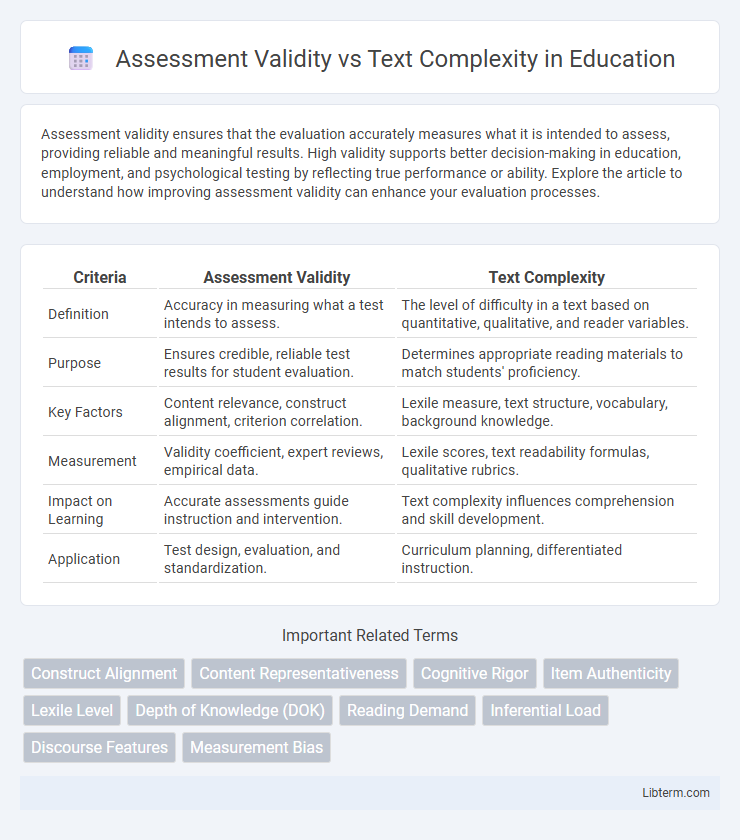Assessment validity ensures that the evaluation accurately measures what it is intended to assess, providing reliable and meaningful results. High validity supports better decision-making in education, employment, and psychological testing by reflecting true performance or ability. Explore the article to understand how improving assessment validity can enhance your evaluation processes.
Table of Comparison
| Criteria | Assessment Validity | Text Complexity |
|---|---|---|
| Definition | Accuracy in measuring what a test intends to assess. | The level of difficulty in a text based on quantitative, qualitative, and reader variables. |
| Purpose | Ensures credible, reliable test results for student evaluation. | Determines appropriate reading materials to match students' proficiency. |
| Key Factors | Content relevance, construct alignment, criterion correlation. | Lexile measure, text structure, vocabulary, background knowledge. |
| Measurement | Validity coefficient, expert reviews, empirical data. | Lexile scores, text readability formulas, qualitative rubrics. |
| Impact on Learning | Accurate assessments guide instruction and intervention. | Text complexity influences comprehension and skill development. |
| Application | Test design, evaluation, and standardization. | Curriculum planning, differentiated instruction. |
Understanding Assessment Validity
Assessment validity ensures that evaluation tools accurately measure the intended skills or knowledge, critical for interpreting results correctly. Text complexity influences the difficulty level of reading materials, impacting how well assessments reflect a student's comprehension abilities. Understanding the interplay between assessment validity and text complexity guides educators in selecting appropriate texts that align with learning objectives and accurately gauge student performance.
Defining Text Complexity
Text complexity refers to the qualitative and quantitative attributes that determine the difficulty level of a text for readers, encompassing factors such as vocabulary sophistication, sentence structure, and conceptual depth. Defining text complexity involves analyzing readability measures (e.g., Lexile scores), reader-task considerations, and qualitative dimensions like knowledge demands and the text's coherence. Accurate evaluation of text complexity is essential to ensure assessment validity by aligning texts with learners' proficiency and cognitive capabilities.
The Relationship Between Validity and Text Complexity
Assessment validity is closely linked to text complexity, as valid assessments must align with the intended reading level and cognitive demand of the texts used. Text complexity measures, including qualitative features (such as theme and structure), quantitative metrics (like Lexile scores), and reader-task considerations, directly impact the accuracy of interpreting student comprehension and skills. Validity improves when assessments account for these text complexity factors, ensuring that results reflect true reading proficiency rather than extraneous challenges or oversimplifications.
Types of Assessment Validity
Assessment validity encompasses content, construct, and criterion-related validity, each ensuring that tests accurately measure intended skills or knowledge. Content validity verifies the alignment of assessment items with the target curriculum standards and instructional goals, critical when addressing text complexity. Construct validity ensures that assessments truly evaluate the cognitive processes involved in comprehending complex texts rather than unrelated abilities.
Measuring and Evaluating Text Complexity
Measuring text complexity involves analyzing quantitative factors such as word frequency, sentence length, and text cohesion using tools like Lexile and Flesch-Kincaid scores. Evaluating assessment validity requires aligning these complexity measures with intended learning outcomes to ensure tests accurately reflect students' reading abilities. Effective text complexity evaluation supports valid assessments by matching texts to appropriate grade-level standards and cognitive demands.
Challenges in Aligning Validity with Text Complexity
Aligning assessment validity with text complexity presents challenges due to the subjective nature of text difficulty measurements and the variability in student backgrounds and skills. Standardized metrics like Lexile or Flesch-Kincaid do not fully capture cognitive demands or conceptual understanding required, complicating validity in evaluating comprehension accurately. Ensuring assessments reflect true text complexity requires integrating qualitative factors such as inferential reasoning and prior knowledge dependencies beyond quantitative readability scores.
Impact of Text Complexity on Assessment Outcomes
Text complexity significantly influences assessment validity by affecting students' comprehension and ability to demonstrate knowledge accurately. Higher text complexity can lead to increased cognitive load, which may confound assessment outcomes and distort true student proficiency. Evaluating text complexity involves analyzing quantitative measures, qualitative factors, and reader-task considerations to ensure assessments reflect genuine learning rather than reading difficulty.
Best Practices for Balancing Validity and Complexity
Balancing assessment validity and text complexity involves designing tasks that accurately measure student comprehension without overwhelming their reading skills. Incorporate texts that align with students' grade-level lexile measures while embedding diverse question types targeting both surface-level understanding and deeper analytical skills. Ensuring scaffolded supports and clear rubrics helps maintain assessment fairness and validity amid complex text selections.
Tools and Metrics for Assessing Text Complexity
Tools for assessing text complexity include the Lexile Framework, Flesch-Kincaid Grade Level, and Coh-Metrix, which analyze factors like word frequency, sentence length, and syntactic cohesion. Metrics such as vocabulary diversity, syntactic complexity, and text cohesion are critical for evaluating how well a text matches readers' comprehension abilities, ensuring alignment with assessment validity. Employing these tools enhances the accuracy of measuring text difficulty, thereby supporting valid and reliable assessments in educational settings.
Future Directions in Assessment Validity and Text Complexity
Future directions in assessment validity emphasize integrating adaptive learning technologies to better align with diverse text complexities, ensuring more accurate measurement of student comprehension and skills. Advances in natural language processing enable dynamic text complexity analysis, supporting the development of assessments that reflect authentic reading experiences and cognitive demands. Emphasizing continuous validation through large-scale data analytics can enhance the precision and fairness of assessments across varied linguistic and cultural contexts.
Assessment Validity Infographic

 libterm.com
libterm.com